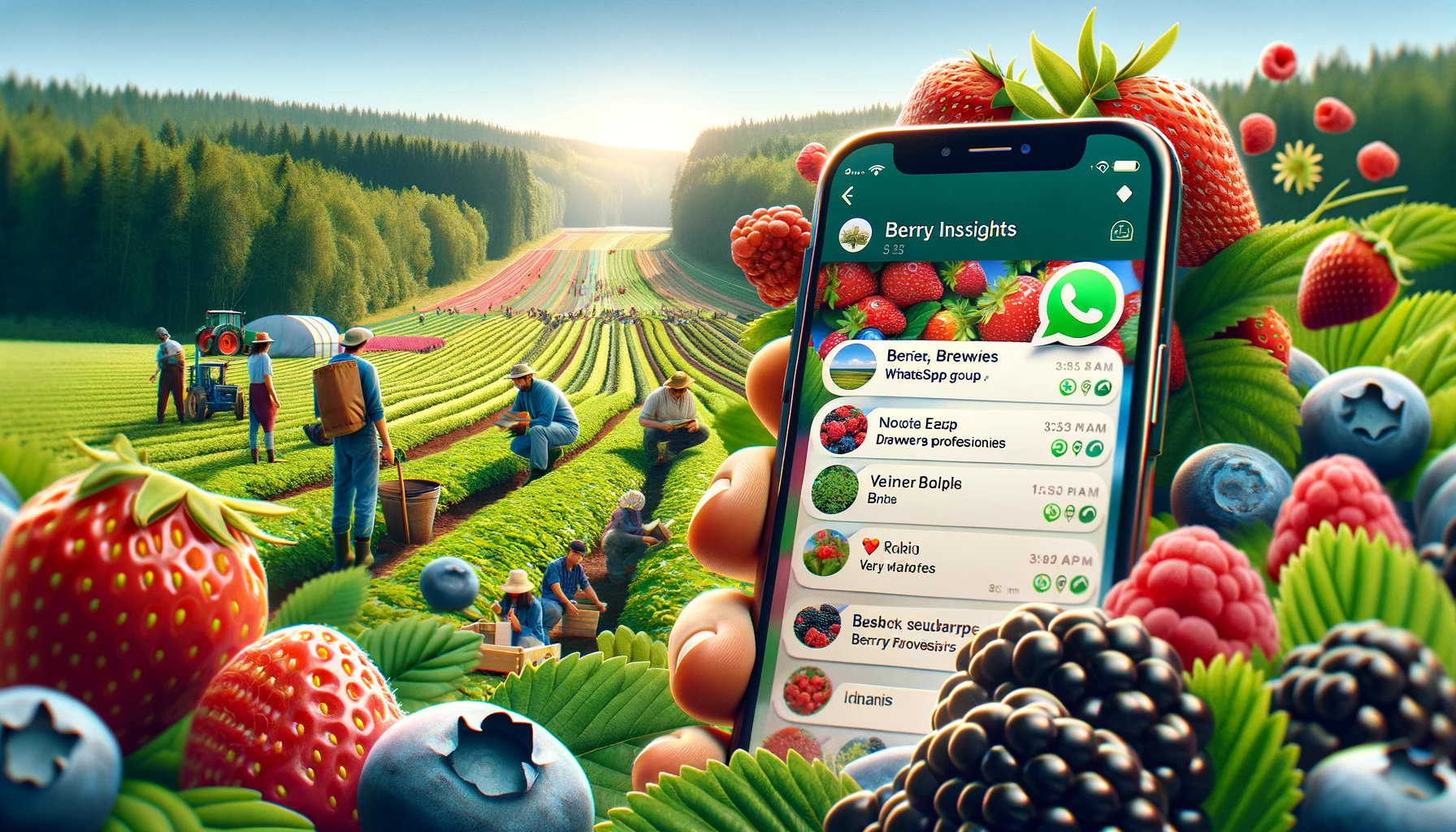This article was originally published in 'Besseres Obst' (the Austrian periodical specialising in fruit production and processing) by Thomas Drahorad.

World blueberry productionhas been growing for 20 years at a rate unmatched by any other fruit and vegetable. What factors in consumption, production, areas of origin and varieties are underpinning this development? And, more importantly, can Austrian agriculture look at this crop with interest and invest in it for the foreseeable future?
Let's start with a clarification: in this article we will talk about the American giant blueberry (Vaccinium corymbosum), which we must distinguish from the wild blueberry (Vaccinium myrtillus) that we know because it grows in our mountains and is part of our tradition. The cultivated blueberry is native to the United States, where it was selected in the early 1900s as a development of the wild blueberry by Frederick Coville. The first commercial harvest of cultivated blueberry dates back to 1916 in New Jersey.
Since then, the development of the crop has led to a worldwide harvest of blueberries of around 2 million tonnes, which is more than eight times Austria's apple production, and which is equally used for fresh and frozen consumption.
Worldwide, the two markets where blueberries is most widely consumed are the United States and the United Kingdom. Both of these markets have seen a concerted marketing effort between producers and importers, resulting in higher growth rates in quantities sold than any other product in the fruit and vegetable department. In the UK market, blueberries retails for almost €500 million each year and has a per capita consumption of 727g. In the US, per capita consumption is around 1.5 kg per year. In both markets penetration (% of households buying regularly) is over 50%.
In the period 2016-2018, European consumption of blueberries increased by 23% to an average consumption of 250g per capita. Experts have recently projected 2 million tonnes of fresh blueberries to be consumed globally within the next 10 years, and 860g per head in Europe by 2026. The past 12 months marked by the pandemic have not changed these estimates and blueberries continues its double-digit growth in all major world markets.
GROWTH FACTORS
Among the main reasons for this continuous growth are the health benefits (due to the high content of anthocyanins, antioxidants, flavonoids and vitamin C) demonstrated by many scientific studies, the variety of conditions of use (it can be consumed in many ways both fresh and preserved) and the occasions of use (at breakfast with yoghurt, as a fast-breaking snack, as a fruit to eat outside the home, as part of a healthy meal).
For the retail trade blueberry is valued for its excellent shelf life (at least one week after purchase for the consumer) and its availability for 12 months a year. All these factors are regularly promoted by the professional operators of blueberries and berries, who in many countries are associated to co-ordinate production, marketing and promotion with the aim of increasing consumption.
DISTRIBUTION BY CHANNELS AND MARKET SEGMENTATION
Unlike other berries such as currants and strawberries, blueberries is sold almost exclusively in large-scale retail channels . In more advanced markets, where blueberry is the subject of concerted marketing actions, differentiation has made it possible to better meet the different needs of consumers: in addition to the standard lines (which in Austria represent the majority of sales), various market segments have developed: premium (with varieties of superior size and taste), discount (with undifferentiated varieties and sizes), local (which favours national production in the various markets), organic and zero residue.
SEASONAL ADJUSTMENT
An element that has allowed a regular development of sales has also been the strong seasonal adjustment of the product. Originally, the product was offered on the Austrian market mainly in summer with domestic product (July to September) and then in December-April from South America (Chile and Argentina), with large periods of price peaks and speculation. In recent years, with the entry of new producing countries (mainly Spain, Poland, Morocco and Peru), the availabilitycalendar has undergone structural adjustments so that in a few years the availability of producthas increased on a regular basis over all 12 months.
PRODUCTION ZONES
While the world calendar is populated with new origins, a process of widespread production of blueberries is also underway in Austria. While until 2016 production remained relatively stable at around 125-140 hectares and around 900 tonnes, since 2017 a growth has started, bringing the blueberry cultivated in Austria in 2019 to 202 hectares and 1349 tonnes (AMA estimates), about twice the area in production for raspberries.

Austrian berry imports increased by 43% in the period 2013-2017 and consumption increased by 27% in the same period (AMA). This seems to indicate that for blueberries there is room for growth for both domestic production and the imported product.
However, Austrian production overlaps as a timetable with other production from neighbouring countries (mainly Poland and Serbia) which arrive on the markets with normally more aggressive prices in the same period.
GEOGRAPHICAL MARKETS
There is still a big difference between local, national and foreign markets. For small producers, the local market is an interesting source of income, but as soon as you grow more than a few hundred plants, you need to move into more structured markets. However, these markets are much more exposed to international competition, which is almost always available in quantity and at very competitive prices. Prices for Austrian producers can therefore be halved if they switch from local to national or international distribution.
HOW TO CHOOSE BLUEBERRY FOR PLANTING?
The cultivation of blueberry, although originating in continental climates, has spread over the last 20 years to all climatic zones and is now produced from the desert areas of Peru to the northern climates of the Baltic countries, from Africa to England and in the United States (the world's largest producer) from warm Florida to continental New Jersey.
Thetype of blueberry that is suitable for the Austrian climate is the 'Northern Highbush', which has a wide range of varieties from the earliest (producing from July) to the latest. The most common varieties are Duke, Draper, Aurora, Bluecrop, Cargo, Elliott, Last Call, Liberty, Top Shelf.
An important factor in the investment decision must be the type of soil, which for blueberry must have a high acidity of between 4.5 and 5.5. If the soil does not meet these requirements, it is necessary to resort to pot cultivation, the technique of which is now well established and which allows blueberries to be produced by means of a controlled supply of nutrients to a substrate such as peat and coconut fibre, contained in pots or bags.
Winter pruning is an important step to ensure good quality and size production from the blueberry plants. It should be done every year to avoid overgrowth of the plant and to build an optimal bush shape to maximise quantity and minimise harvesting costs.
The blueberry plantcomes into production after 1-2 years, although it is better to limit production in the first 2-3 years to allow for ideal plant development. After 5-6 years, the plant reaches full production, which is about 5 kg. Normally, 2200 to 3000 plants are planted on one hectare.
CONCLUSIONS
The Austrian production of blueberries, which has been growing in recent years, is part of a worldwide trend in which both the quantities produced and consumption are increasing at very high rates. The global landscape is changing very quickly with the continual rise of new producing countries (both in Europe and in the Southern Hemisphere) which, thanks to their high adaptability to different soil and climate conditions, can produce without any particular difficulty in practically any climate.
But this necessarily requires a number of factors: coordination of the supply chain (from nursery to supermarket) to raise awareness among Austrian consumers, the willingness of producers to invest in varieties that are not only beautiful and productive but also pleasing to consumers (who appreciate above all a tasty and healthy blueberry ), and cooperation with other producers worldwide, who can contribute effectively to the development of the national market.









